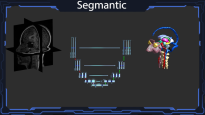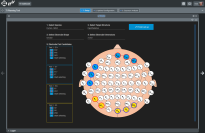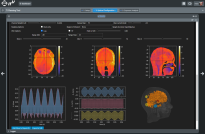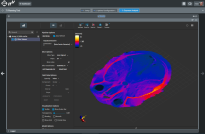
 Personalization: Automatic segmentation from magnetic resonance images.
Personalization: Automatic segmentation from magnetic resonance images.
 Setup: Selection of electrodes and placement.
Setup: Selection of electrodes and placement.
 Identification of optimal configuration: Visualization and report generation.
Identification of optimal configuration: Visualization and report generation.
 Exposure analysis: Interactive exploration and visualization in Sim4Life.web.
Exposure analysis: Interactive exploration and visualization in Sim4Life.web.
 Visualization of advanced phase modulation schemes and pulse shapes of the complete electric field and its x-, y- and z-components in TIP.
Visualization of advanced phase modulation schemes and pulse shapes of the complete electric field and its x-, y- and z-components in TIP.
TI Planning Tool TIP
At IT’IS, we are committed to supporting innovative, safe, and effective therapies through cutting-edge computational life sciences.
Background
Temporal interference (TI) and its potential to selectively stimulate deep brain regions without activating overlaying structures has recently attracted huge interest and stimulated a large number of animal and human studies.
IT’IS has been dealing with an exponential increase of requests from research groups to use our computational modeling tools and expertise to create optimized protocols for planned or ongoing studies. To satisfy that large demand and provide neuroscientists and brain stimulation experts who have little expertise or experience with computational modeling with a tool to their stimulation protocols, IT'IS has developed the TI planning tool, TIP.
The TIP Tool
TIP is a novel online tool powered by o²S²PARC technology that reduces optimization of targeted neurostimulation protocols to a few simple steps:
(i) definition of target brain regions and constraints on potential electrode placement,
(ii) identification of an optimized stimulation protocol – based on sophisticated electromagnetic simulations involving detailed anatomical head models, automated multi-goal optimization, and interactive refinement – and export of a detailed report with quantitative and visual information,
(iii) interactive exposure analysis using the powerful functionality of Sim4Life.web.
Versions
| Version | URL | Users |
| TIP V3.0 | tip.science | Early Adopter Program, TI Solutions AG |
| TIP.lite | tip-lite.science | Students and Researchers |
| TIP V2.2 | discontinued | n/a |
Future Releases
IT’IS will continue to develop and extend the TIP tool. Foreseen upcoming functionality – based on currently ongoing research of IT’IS and collaborating research groups – will include:
- a further extended field library (more head models, other species, different electrode shapes)
- a repository of TI stimulation protocols established by different research groups
- more optimization functional flexibility
- brain activity modeling
- surrogate modeling
- additions requested by the users
Request & Inquiries
TIP is available to groups enrolled in the TI Solutions Early Adopter Program and to TIBS-R users at no cost. In case of interest, please contact us to obtain access to TIP.
For further information, please send us an email or call +41 44 245 9898.
Make sure to also check out the latest version of the TI Brain Stimulator for Research (TIBS-R) from our Z43 partner TI Solutions AG.
Acknowledgment
We gratefully acknowledge the clinical insights, and critical feedback of the teams of Prof. Grossman (Imperial College) and Prof. Hummel (EPFL).



